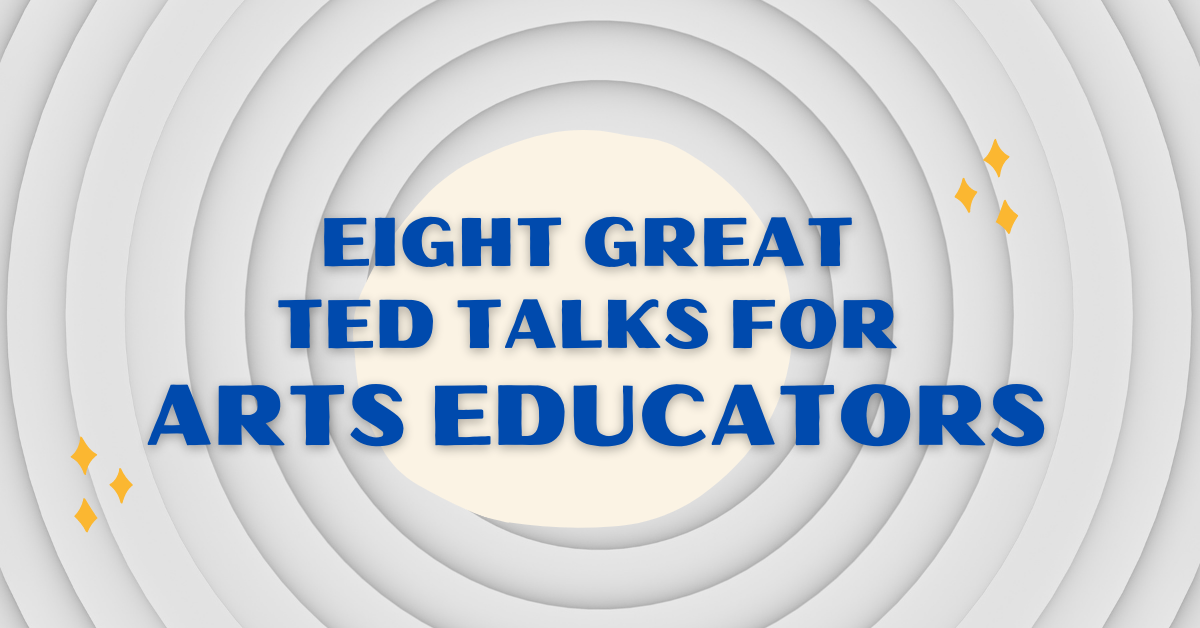Eight Great TED Talks for Arts Educators
TED is an organization that arranges conferences around the notion of “Ideas Worth Spreading.” Many of the talks centre around science and technology, but they also have a healthy amount of arts-related presenters.
Here are eight noteworthy talks that I think would be of particular interest to arts educators.
Ken Robinson: How schools kill creativity
This talk is nearly eight years old and it’s as important as ever to pay attention to its lessons.
Summary (from TED)
Sir Ken Robinson makes an entertaining and profoundly moving case for creating an education system that nurtures (rather than undermines) creativity.
Creativity expert Sir Ken Robinson challenges the way we’re educating our children. He champions a radical rethink of our school systems, to cultivate creativity and acknowledge multiple types of intelligence.
Quotes
“Kids will take a chance. If they don’t know, they’ll have a go. Am I right? They’re not frightened of being wrong. Now, I don’t mean to say that being wrong is the same thing as being creative. What we do know is, if you’re not prepared to be wrong, you’ll never come up with anything original — if you’re not prepared to be wrong. And by the time they get to be adults, most kids have lost that capacity.”
“Every education system on earth has the same hierarchy of subjects. Every one. Doesn’t matter where you go. You’d think it would be otherwise, but it isn’t. At the top are mathematics and languages, then the humanities, and the bottom are the arts. Everywhere on Earth. And in pretty much every system too, there’s a hierarchy within the arts. Art and music are normally given a higher status in schools than drama and dance.”
“If you think of it, the whole system of public education around the world is a protracted process of university entrance. And the consequence is that many highly talented, brilliant, creative people think they’re not, because the thing they were good at at school wasn’t valued, or was actually stigmatized. And I think we can’t afford to go on that way.”
“[Gillian Lynne] eventually graduated from the Royal Ballet School and founded her own company. She’s been responsible for some of the most successful musical theater productions in history; she’s given pleasure to millions; and she’s a multi-millionaire. Somebody else might have put her on medication and told her to calm down.”
Lessons Learned
Robinson’s talk is spot on. He not only highlights flaws in our current system, but he offers tools to change it.
It’s also a brilliant example of how to engage the audience through humour when giving a speech that could easily be a procession of slides and graphs.
Phil Hansen: Embrace the shake
Summary (from TED)
In art school, Phil Hansen developed an unruly tremor in his hand that kept him from creating the pointillist drawings he loved. Hansen was devastated, floating without a sense of purpose. Until a neurologist made a simple suggestion: embrace this limitation … and transcend it.
Taking a cue from his own artistic journey, Phil Hansen challenges us to spark our creativity by thinking inside the box.
Quotes
“I went home, I grabbed a pencil, and I just started letting my hand shake and shake. I was making all these scribble pictures. And even though it wasn’t the kind of art that I was ultimately passionate about, it felt great. And more importantly, once I embraced the shake, I realized I could still make art. I just had to find a different approach to making the art that I wanted.”
“As I destroyed each project, I was learning to let go, let go of outcomes, let go of failures, and let go of imperfections. And in return, I found a process of creating art that’s perpetual and unencumbered by results. I found myself in a state of constant creation, thinking only of what’s next and coming up with more ideas than ever.”
“Limitations may be the most unlikely of places to harness creativity, but perhaps one of the best ways to get ourselves out of ruts, rethink categories and challenge accepted norms. And instead of telling each other to seize the day, maybe we can remind ourselves every day to seize the limitation.”
Lessons Learned
Art comes from limitations. Hansen’s limitation is nothing any of us would want to have, but instead of giving up forever, he found a way to do what he loves anyway.
Limitations like this seem insurmountable but they make your mind focus; problem solve. I see so many people focusing on the fact that their programs don’t have any money. What if they embrace that? What can you get for free?
Neil Harbisson: I listen to color
Summary (from TED)
Artist Neil Harbisson was born completely color blind, but these days a device attached to his head turns color into audible frequencies. Instead of seeing a world in grayscale, Harbisson can hear a symphony of color — and yes, even listen to faces and paintings.
Neil Harbisson’s “eyeborg” allows him to hear colors, even those beyond the range of sight.
Quotes
“So, life has changed dramatically since I hear color, because color is almost everywhere, so the biggest change for example is going to an art gallery, I can listen to a Picasso, for example. So it’s like I’m going to a concert hall, because I can listen to the paintings.”
“So today I’m dressed in C major, so it’s quite a happy chord. If I had to go to a funeral, though, I would dress in B minor, which would be turquoise, purple and orange.”
Lessons Learned
As with Phil Hansen’s speech, Harbisson has a limitation he embraces and uses to make art.
Reggie Watts: Beats that defy boxes
Summary (from TED)
Reggie Watts’ beats defy boxes. Unplug your logic board and watch as he blends poetry and crosses musical genres in this larger-than-life performance.
Reggie Watts creates unpredictably brilliant performances on the spot using his voice, looping pedals and his giant brain.
Quotes
“Now with the allocation and the understanding of the lack of understanding, we enter into a new era of science in which we feel nothing more than so much so as to say that those within themselves, comporary or non-comporary, will figuratively figure into the folding of our non-understanding and our partial understanding to the networks of which we all draw our source and conclusions from.”
Lessons Learned
Watts’s speech is utterly fascinating. The talk is actually complete nonsense but it feels like he’s saying something profound. So your brain does its best to get some meaning from it, to assemble some sense out of the chaos.
Elizabeth Gilbert: Your elusive creative genius
Summary (from TED)
Elizabeth Gilbert muses on the impossible things we expect from artists and geniuses — and shares the radical idea that, instead of the rare person “being” a genius, all of us “have” a genius. It’s a funny, personal and surprisingly moving talk.
The author of ‘Eat, Pray, Love,’ Elizabeth Gilbert has thought long and hard about some large topics. Her latest fascination: genius, and how we ruin it.
Quotes
“Is it logical that anybody should be expected to be afraid of the work that they feel they were put on this Earth to do.”
“I’m a mule, and the way that I have to work is that I have to get up at the same time every day, and sweat and labor and barrel through it really awkwardly.”
“[D]on’t be afraid. Don’t be daunted. Just do your job. Continue to show up for your piece of it, whatever that might be. If your job is to dance, do your dance.”
Lessons Learned
Basically, her speech can be summed up with the Nike slogan “Just do it.” If you’re a writer, write. If you’re a singer, sing. If you’re an actor, act. Don’t focus on why you can write or what’s stopping you from writing, just sit down and move that pen. The geniuses are the ones who show up and do the work, good, bad, or ugly.
Dave Morris: The Way of Improvisation
Summary (from TED)
Dave Morris shows you The Way of Improvisation. He takes you on a journey through the seven steps of improvising:
- Play
- Let Yourself Fail
- Listen
- Say “Yes”
- Say “And”
- Play the Game
- Relax and Have Fun
Quotes
“Life, believe it or not, is improvised.”
“Failing is easy. We can all do it. The hard part is to be OK with that and to let yourself fail and accept that failure is a natural way of things.”
“A series of yesses will take us somewhere. A series of noes doesn’t even get started… You can have 10,000 yesses in a row and it takes just one no to stop it all and ruin it.”
“Anything that has rules to it, I consider a game. So Monopoly, that’s a game. Filling out a job application, to me, that’s a game. There are rules that I am following. And what rules do is they free us up to improvise.”
Lessons Learned
This is the greatest video to show at the beginning of an improv unit. And in the middle of an improv unit. And at the end of an improv unit. It speaks to the kids who are fearful of improv and it also sets the groundwork for the kids who want to do improv so they can showboat and steal the stage.
While it’s about improv, the lessons can be applied to theatre, or any art form in general.
The games in improv are (similar to Harbisson and Hansen) limitations. Improv teaches you to embrace and flourish within a set of limitations.
Mark Stewart – A Private Duet, 350 Strong
Summary
Mark is an accomplished musician, regularly touring with the likes of Paul Simon. As he says in his talk: “On a pop tour you have two options. You can either work on a new drug habit or you can have a project.” He chose the project.
Mark makes music from everything – especially items cast away as garbage, things he finds in dumpsters. He’s an engaging speaker and his talk is a clear example of the importance of arts education. The end of the talk features a private duet with every person in the audience. Enjoy!
Quotes
“I believe that the word ‘musician’ is too often used to discourage people from participating in their birthright as soundmakers. We are all soundmakers.”
“I like the way my brain works when I’m looking at garbage.”
“‘Can it play a C-Major scale?’ said my esteemed colleague. You know, I think the C-Major scale has enough friends already.”
Lessons Learned
The first part of the talk is a clear message why arts has to be mandatory for all students. Kids have had creativity beaten out of them, think they can’t sing, think they can’t talk in front of an audience, think they can’t write creatively, think they can’t paint or draw. Classes like Stewart’s teach kids to open themselves up to the possibilities that maybe they can.
The second part is a return to what’s quickly becoming a pattern in these talks: embracing limitations. This man has money. He can afford to buy any musical instrument he wants. But he chooses to limit himself to making music from ordinary everyday objects. Why is that?
Julie Taymor: Spider-Man, The Lion King and life on the creative edge
Summary (from TED)
Showing spectacular clips from productions such as Frida, The Tempest and The Lion King, director Julie Taymor describes a life spent immersed in theater and the movies. Filmed right as controversy over her Broadway production of Spider-Man: Turn Off the Dark was at its peak, she candidly describes the tensions inherent within her creative process, as she strives both to capture the essence of a story–and produce images and experiences unlike anything else.
Julie Taymor is a film, theater and opera director. She is known for lavish movies such as Frida and for her hit Broadway musicals, The Lion King and Spider-Man: Turn Off the Dark.
Quotes
“[Y]ou must be true to what you believe as an artist all the way through, but you also have to be aware that the audience is out there in our lives at this time, and they also need the light. And it’s this incredible balance that I think that we walk when we are creating something that is breaking ground, that’s trying to do something you’ve never seen before, that imaginary world where you actually don’t know where you’re going to end up, that’s the fine line on the edge of a crater that I have walked my whole life.”
“I start with the notion of the ideograph. An ideograph is like a brush painting, a Japanese brush painting. Three strokes, you get the whole bamboo forest. I go to the concept of The Lion King and I say, ‘What is the essence of it? What is the abstraction? If I were to reduce this entire story into one image, what would it be?’ The circle.”
“[W]hat I know and love about the theater is that when the audience comes in and they suspend their disbelief, when you see men walking or women walking with a platter of grass on their heads, you know it’s the savanna. You don’t question that.”
“And I’m one who loves high tech and low tech… I’ll show you some Spider-Man, these incredible machines that move people along. But the fact is, without the dancer who knows how to use his body and swing on those wires, it’s nothing.”
Lessons Learned
The visuals are spectacular in this talk. Taymor works with all manner of materials in creating her art, from very simple objects like sticks and rags (The Lion King) up to the complex multi-million dollar machines (Spider-Man: Turn off the Dark).



